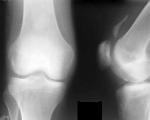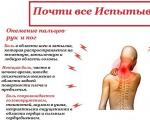The pubic bone hurts during pregnancy or after childbirth: its structure, functions, causes of pain, prevention and treatment + Photo
The pubic bone can become injured or inflamed. In this case, it is necessary to consult with a traumatologist or gynecologist. This pathology requires careful diagnosis. When the pubic bone hurts, the intensity does not matter, it is important to seek help.
The pubic bone is part of the bones that form the pelvic bone. The pubis consists of two branches and a body, forming a closing opening with a membrane.
Women with a normal physique have a roller-like bone in thickness equal to the thumb. It is curved and is a pubic eminence. The bone, like an arch, hangs over the entrance to the vagina, growing together with the pelvic bones.
The pubic bone is paired, connects to the cartilage and forms a symphysis or pubic joint, in which pain usually appears.
The distance between the pubic bones is normally no more than 5 mm. During pregnancy, this figure changes by 3 mm upwards.
If the pubic bone hurts
Causes of pain
... in men
Men experience pain associated with trauma to the pubic bone. These can be bruises, closed or open fractures.
There are the following situations associated with injuries:
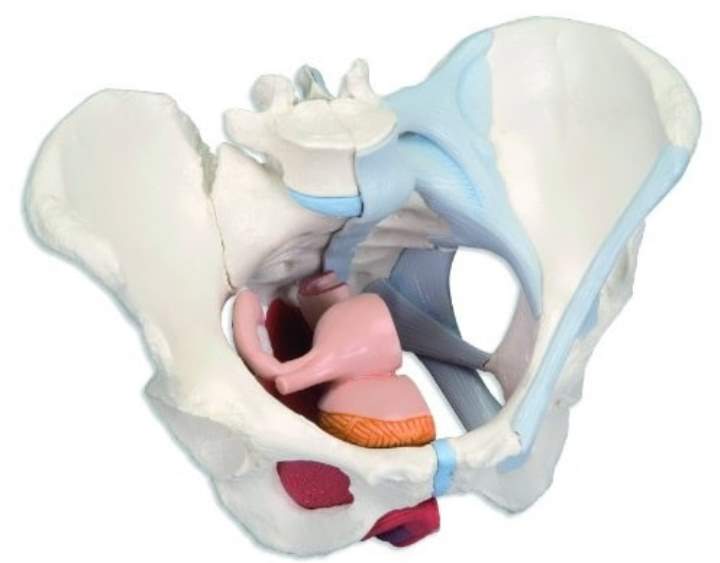
…among women
Women, in addition to trauma to the pelvic region, may have gynecological problems, for example:
- during pregnancy in the second half there is a softening of the joints between the bones, the so-called symphysiolysis syndrome;
- symphysitis or divergence of bone tissue up to separation during delivery;
- congenital pathologies associated with the structure of the small pelvis.
What does symphysis mean?
Women after childbirth experience pain in the pubic bone. Most likely, the process of divergence, that is, the violation of the integrity of the symphysis, influenced this. This is considered a traumatic complication of labor or rupture.
3 degrees of discrepancy are determined:
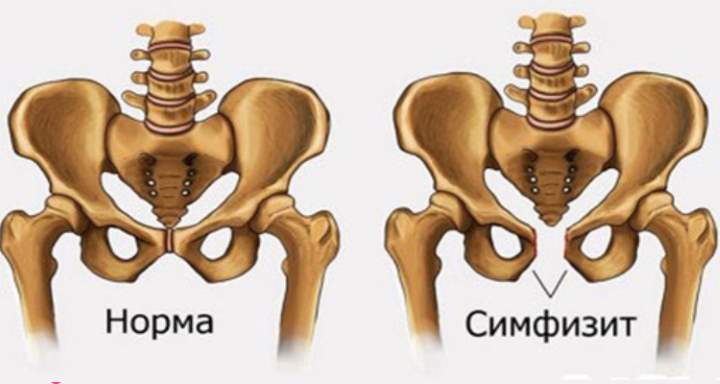
The degree does not affect the treatment process. It is necessary in any case. The issue is resolved with a gynecologist.
The causes of the disease have not yet been identified. Scholars are divided in opinion. Some consider it a consequence of calcium deficiency in the body, others blame the increased concentration of relaxin.
Pubic pain in pregnancy
Expectant mothers often experience pain in the pubic symphysis, which occurs mainly in the last trimester of pregnancy.
This happens due to softening of the interosseous joint. Pain differs in its characteristics:
- it is pronounced, especially during movements - turning the body, climbing stairs or from bed;
- worse after dinner;
- swelling appears in the symphysis area;
- if you press on the pubis, you can hear a click;
- a woman cannot raise straight legs from a prone position;
- pain when urinating;
- duck gait with characteristic small steps.
Not everyone is susceptible to this pathology, and the answer to the question by what criteria the disease chooses a victim has not been found.
For the development of symphysitis, several processes have a large function:
- After the first half of pregnancy, the hormone relaxin is produced in greater quantities. It is necessary for every woman to prepare the body for the birth process. Thanks to the hormone, the womb loses its rigidity and becomes pliable so that the pelvis can increase during delivery. But, at the same time, resistance to any loads decreases.
- A decrease in calcium in the body, leaving for the formation of the baby's musculoskeletal system. This process causes symptoms of a degenerative bone change called osteoporosis.
- Intrauterine disturbance during the formation of the pubic joint or in childhood also leads to symphysitis.
With an acute rupture of the symphysitis, the pain is severe.
Where to go if the pubis hurts
In case of damage, regardless of a man or a woman, it is necessary to visit a traumatologist for a consultation.
If there is no possibility of independent movement or the patient is in serious condition, an ambulance should be called.
With pain during the period of bearing a child, as well as in the postpartum period, it is urgent to make an appointment with a gynecologist. It will also help if pain occurs during intercourse.
How is the disease diagnosed in pregnant women
Diagnosis is an important step. At the initial appointment, an anamnesis is collected, complaints are heard. It is necessary to try to describe in detail the nature of the pain - when it appears, with what movements it intensifies, etc.
Next, the gynecologist conducts a standard examination, determines the size of the pelvis, the location of the fetus. Laboratory tests are also indicative. Pay attention to the level of calcium in the blood, the amount of estrogen and progesterone.
Among the visual examination for pregnant women, only ultrasound is available, which can show the pubic articulation and the condition of the fetus.
When a discrepancy appears after childbirth, the patient is referred for an x-ray or CT scan of the pelvis.
Pathologies causing pubic pain
The beautiful half of humanity is faced with pain in the pubic area for other reasons. It could be:
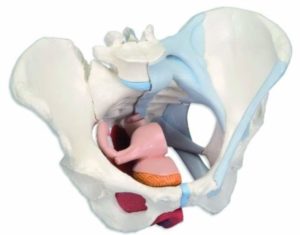
Some women are owners of a flat saber-shaped pubis. The problem is that a bar 3 fingers wide, or maybe more, almost half closes the vagina, which affects a full-fledged sex life.
Pain occurs when the penis presses on the periosteum and presses the urethra against the edge of the pubis. It is necessary to seek help from a gynecologist and a traumatologist.
Symphysitis treatment
How much the pubic bones have expanded can be judged by the result of the ultrasound and only then decide on the method of treatment.
1st degree of discrepancy
If the degree of discrepancy is up to 10 mm, then the following is assigned:
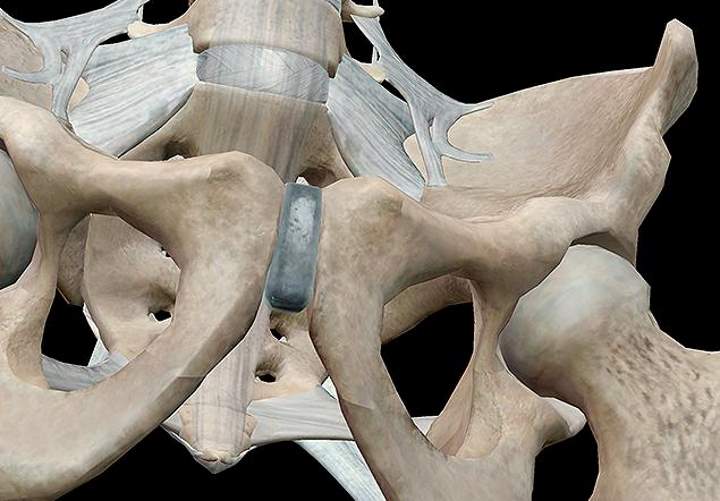
2nd degree of discrepancy
With the second degree of discrepancy, that is, more than 10 mm, it is necessary to use a bandage or corset. This will strengthen the pelvic muscles and reduce pain.
At the same time, natural childbirth is contraindicated for a pregnant woman.
If the pain syndrome is severe, non-steroidal anti-inflammatory drugs are prescribed.
Exercises for any degree of discrepancy
At any stage of the discrepancy, it is prescribed to perform a special gymnastic complex. Exercises are aimed at strengthening the muscles of the pelvis and are not difficult:
- Lying on your back, the legs are bent at the knees and the heels are pulled up to the buttocks. Then the knees are pulled apart very slowly, fixed for 20 seconds and returned to the opposite position.
- The woman lies on her back and raises her pelvis to 5 cm from the floor. You need to stay in this position for a short time. The heels should be 30 cm from the body.
- The next exercise is called the cat. You need to get on all fours, straighten your back. Slowly the back arches and the head rises. The muscles of the abdomen and thighs work.
Important! During gymnastics, be sure to follow the sensations. In no case should exercises be performed when pain occurs.
Getting rid of the pain of symphysis
With a natural divergence of bones during pregnancy, treatment is not carried out. After childbirth, the ligaments should return to their original state. The doctor at this time may recommend taking No-shpu or drug Menovazin.
 When the patient is in the hospital under the supervision of doctors, at 38 weeks of gestation, it is allowed to deal with pain with non-steroidal anti-inflammatory drugs. Pregnant women are prescribed ibuprofen or paracetamol.
When the patient is in the hospital under the supervision of doctors, at 38 weeks of gestation, it is allowed to deal with pain with non-steroidal anti-inflammatory drugs. Pregnant women are prescribed ibuprofen or paracetamol.
When pain appears at 32 weeks of gestation and after delivery, antibiotics and UV irradiation are prescribed to avoid the formation of an inflammatory process.
Ointments and gels have a big plus in treatment, since when they get on the skin they do not penetrate into the systemic circulation.
If the pain syndrome is severe, then after childbirth, the doctor may prescribe opioid painkillers - fentanyl, or apply epidural anesthesia.
Other Therapies
Folk methods in this case are almost powerless. Their efficiency is low. The main focus is on consuming more calcium. A very popular recipe is a combination of sesame seeds with honey and goat cheese.
Corvalol can help relieve pain when applied to the pubic area. Manual therapy is a fairly common method of treatment. It gently affects the pelvic and femoral muscles.
- - acupuncture, moreover, this method helps to get rid of pain not only for women, but also for men. An effective way and almost painless;
- – visit an osteopath, chiropractic;
- - drainage, in the case of purulent symphysitis;
- - injections of glucocorticoids, NVPS, if the cause is osteoperiostitis.
Important! Any alternative technique should not replace the primary treatment.
What happens if you don't treat
When the patient does not receive the required treatment or delays in seeking help, the discrepancy can cause a severe pain reaction that appears even with the slightest movement, up to a complete loss of mobility.
Rupture of the symphysis is a severe complication. Most often occurs in the last weeks of pregnancy, when the fetus enters the small pelvis with its head and presses on the inflamed and weak ligaments. When a woman breaks, she experiences a severe pain shock.
If the discrepancy is more than 2 cm, then the treatment can only be surgical. In the future, a long recovery and the help of rehabilitators will be required.
Preventive actions
No special techniques created to avoid symphysitis have yet been invented. But, for women with a history of this pathology or an abnormal structure of the pelvis, it is recommended:

In addition, all women who are carrying a child should:
- spend a lot of time outdoors and sunbathing. This will contribute to the production of vitamin D. Relevant for those living in the northern regions of the planet;
- reduce heavy physical exertion, walk less on stairs and on foot;
- perform exercises to strengthen the muscles of the pelvis, swim;
- visit a gynecologist regularly.
Childbirth with problems with the pubic bone
With a large divergence of the pubic articulation - from 1 cm, doctors may suggest a planned caesarean section.
If the discrepancy is from 2 cm, then there is no choice, only surgical delivery to exclude a complete rupture of the ligaments. Otherwise, it may take 3 months of complete immobilization before the fusion of the ligaments.
With the second degree of symphysitis, childbirth takes place naturally, without consequences.
The only thing is that a woman should observe bed rest for 3 days with her pelvis tied with an elastic bandage. It is recommended to use a corset for the next 3 months.


